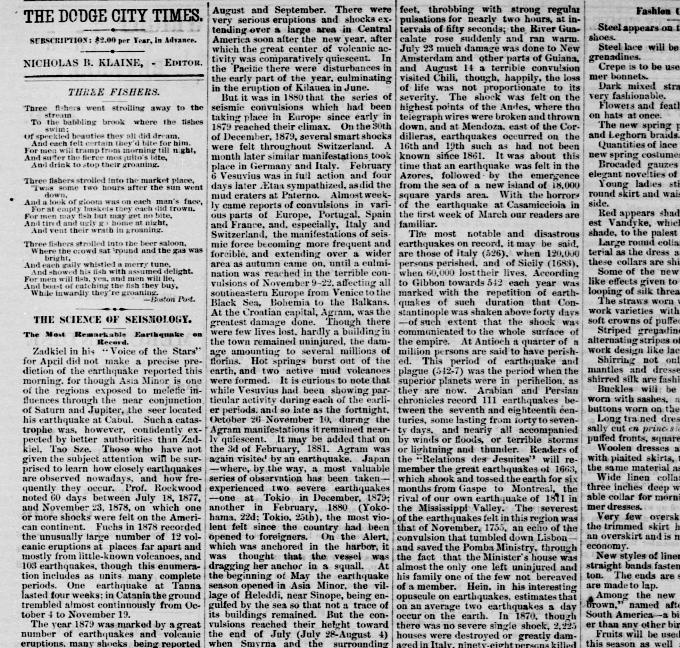|
Moderated by NW Okie! |
Volume 16 , Issue 102014Weekly eZine: (366 subscribers)Subscribe | Unsubscribe Using Desktop... |
Earthquakes of the Late Nineteenth Century

It was in the Dodge City Times, Dodge City Kansas, dated 5 March 1881, page 3, that we found this mention of The Science of Seismology, and the most remarkable earthquake on record.
It stated that those who have not given the subject attention would be surprised to learn how closely earthquakes are observed back then, and how frequently they occurred. Prof. Rockwood noted 60 days between July 18, 1877, and November 23, 1878, on which one or more shocks were felt on the American continent. Fuchs in 1878 recorded the unusually large number of 12 volcanic eruptions at places far apart and mostly from little known volcanoes, and 103 earthquakes, though this enumeration includes as units many complete periods. One earthquake at Tanna lasted four weeks; in Catania the ground trembled almost continuously from October 4 to November 19.
The year 1879 was marked by a great number of earthquakes and volcanic eruptions, many shocks being reported almost at the same instant from places widely separated. On the 8th of January severe shocks were felt in the Caucasus, in the Tyrol and in Luxemburg; on the 9th, the most violent earthquake since 1868 was experienced at Arequipa, Peru; on the 10th shocks were felt at Cologne and throughout Southern Germany; on the 11th, more at Vienna; on the 12th, another violent shaking at Arequipa. In the middle of May eruptions began from Vesuvius; AEtna sympathized on the 25th, pouring out ashes and lava for a fortnight; simultaneously a similar outburst was noted at Geisfugie, Iceland, and on the day that Mt. Aetna broke into activity a violent eruption of the Czobanez mountain in Hungary, long regarded as extinct, was chronicled. As the eruption of Aetna was followed by continuous earthquakes in Sicily until the end of June, so the outbreak of the Czonbanez Mountain was accompanied by severe convulsions in Hungary, Bosnia and Bessarabia, throwing down houses and trees and opening fissures form which water poured in floods, and culminating in the violent shocks at Agram, June 21-22, while tremblings were observed at Aix and Nassau, May 26-27, and at Hastings May 21.
Thereafter Europe had a comparative rest till about the 1st of November, when all the south and east of Hungary, Servia, Roumania and Bessarabia felt incessant earthquakes of considerable intensity, some shocks even lasting a minute. At the time of least activity of volcanic forces in Europe, July 11, three strong shocks were felt in Cairo and near the Pyramids, something unknown in Egypt since 1857. In Persia, March 22-April 2, there were twenty-one villages destroyed and fifty-four greatly damaged; of the 1,200 inhabitants of Manan and Tark but few escaped. Java was visited by several disastrous shocks between March 28 and June 5, its volcanoes being also in active eruption.
China had its turn June 29-July 11, with after shocks of sufficient violence, though to nearly so destructive in August and september. There were very serious eruptions and shocks extending over a large area in Central America soon after the new year, after which the great center of volcanic activity was comparatively quiescent. In the Pacific there were disturbances in the early part of the year, culminating in the eruption of Kilauea in June.
It was in 1880 that the series of seismic convulsions which had been taking place in Europe since early in 1879 reached their climax. On the 30th of December, 1879, several smart shocks were felt throughout Switzerland. A month later similar manifestations took place in Germany and Italy. February 6 Vesuvius was in full action and four days later Aetna sympathized, as did the mud craters at Paterno. Almost weekly came reports of convulsions in various parts of Europe, Portugal, Sapin and France, and, especially, Italy and Switzerland, the manifestations of seismic force becoming more frequent and forcible, and extending over a wider area as autumn came on, until a culmination was reached in the terrible convulsions of November 9-22, affecting all southeastern Europe from Venice to the Black Sea, Bohemia to the Balkans.
The most notable and disastrous earthquakes on record, it may be said, were those of Italy (526), when 120,000 persons perished, and of Sicily (1683), when 60,000 lost their lives. According to Gibbon towards 542 each year was marked wight he repetition of earthquakes of such duration that Constantinople was shaken above forty days, of such extent that the shock was communicated tot he whole surface of the empire.
This period of earthquake and plague (542-7) was the period when the superior planets were in perihelion. Arabian and Persian chronicles record 111 earthquakes between the seventh and eighteenth centuries, some lasting from forty to seventy days, and nearly all accompanied by winds or floods, or terrible storms of lightning and thunder.
Hein, it may be said in conclusion, opposes the theory of a connection between earthquakes and volcanic eruptions and considers that of their coincidence with atmospheric phenomena as better supported by facts; for they are occasionally preceded for accompanied by thick and widespread fogs at seasons when fogs are not frequent, by sudden falls of barometer and equally sudden changes of temperature. Their occurrence, in the majority of cases coincides with normal meteorological conditions.
It was reported in the New York Times back then that Earthquakes are more frequent after sunset than in the daytime, in autumnn and winter than in spring. The influence of the moon is insignificant.
| View or Add Comments (0 Comments)
| Receive
updates ( subscribers) |
Unsubscribe
| © . Linda Mcgill Wagner - began © 1999 Contact Me | |
